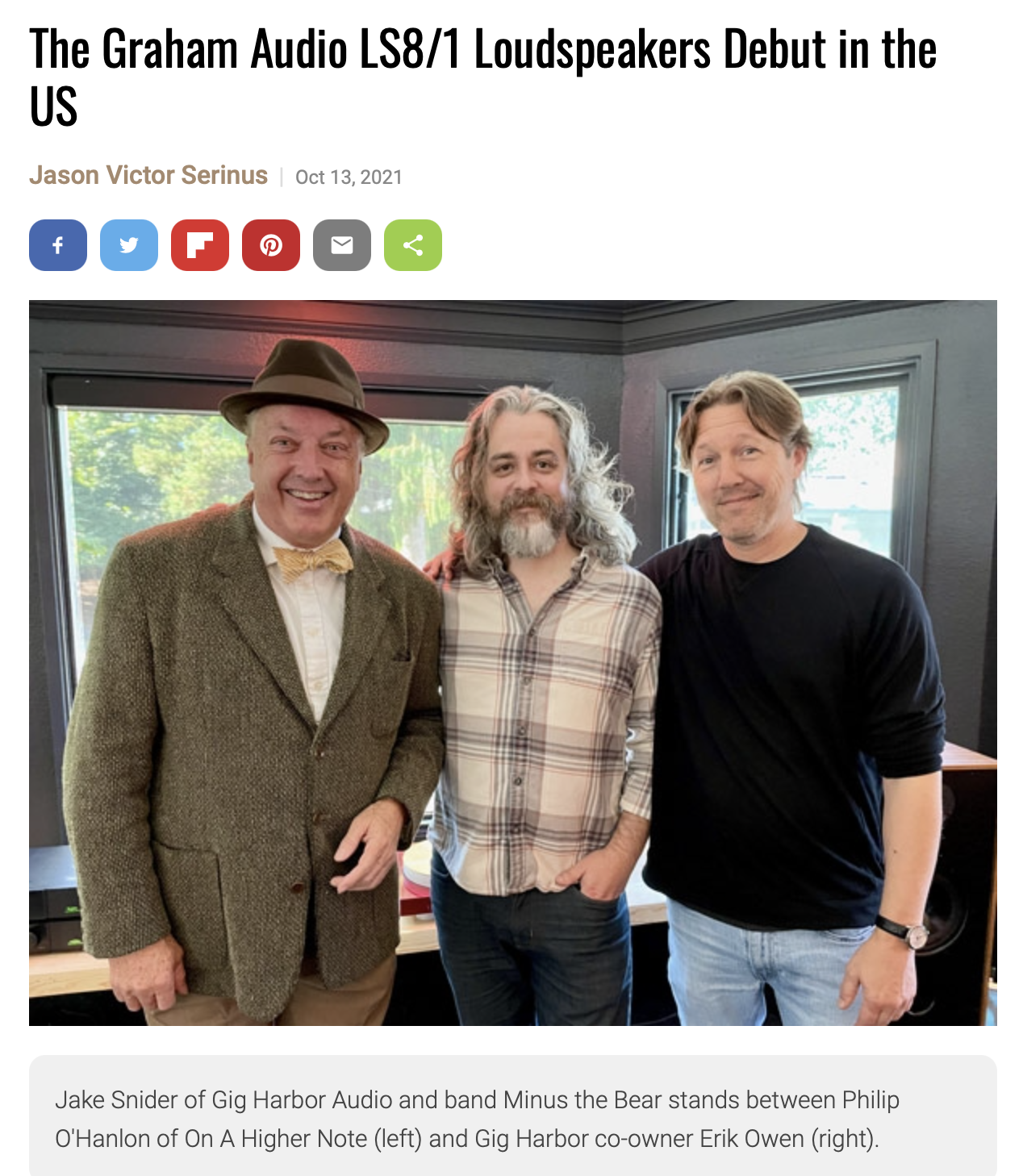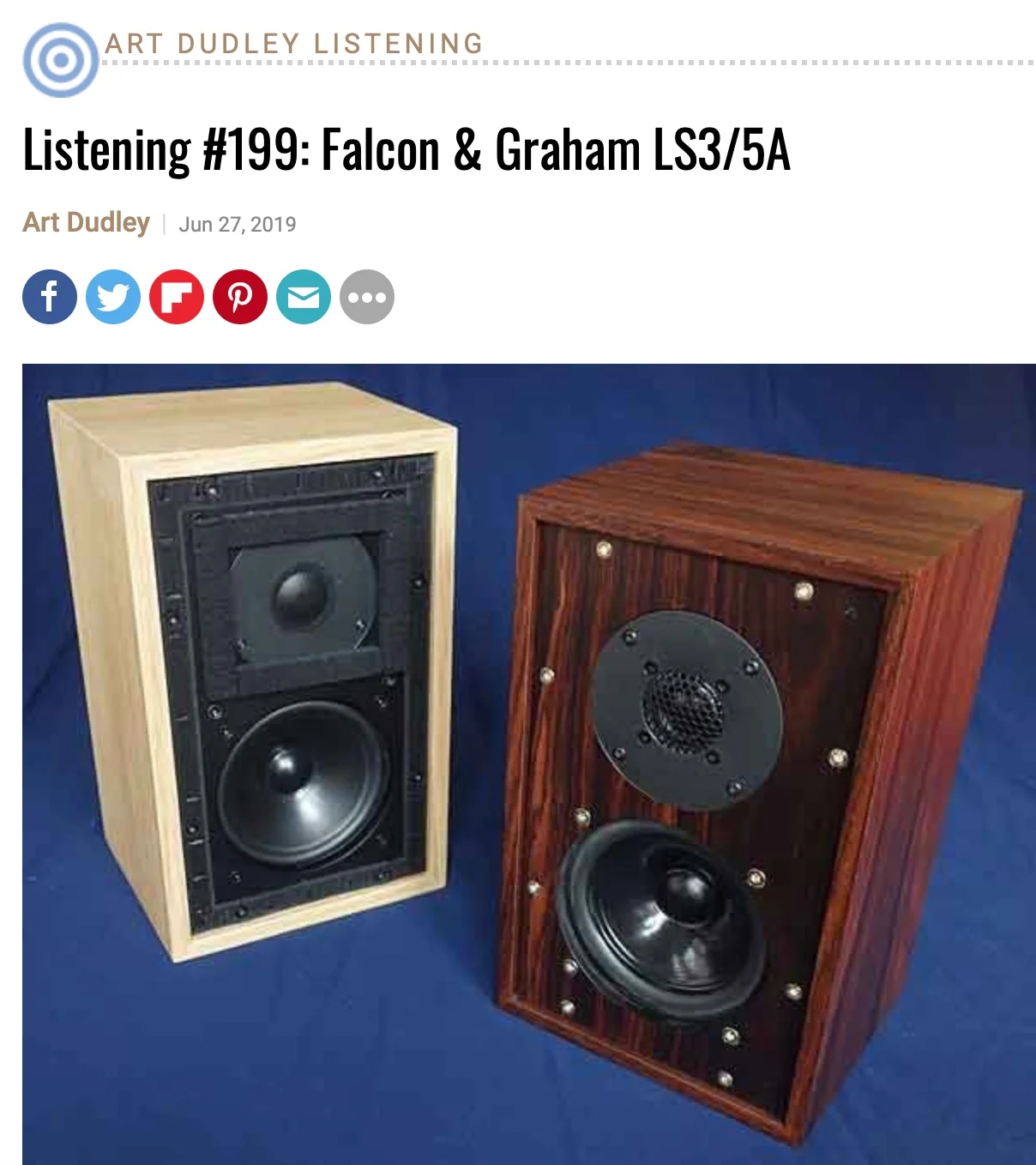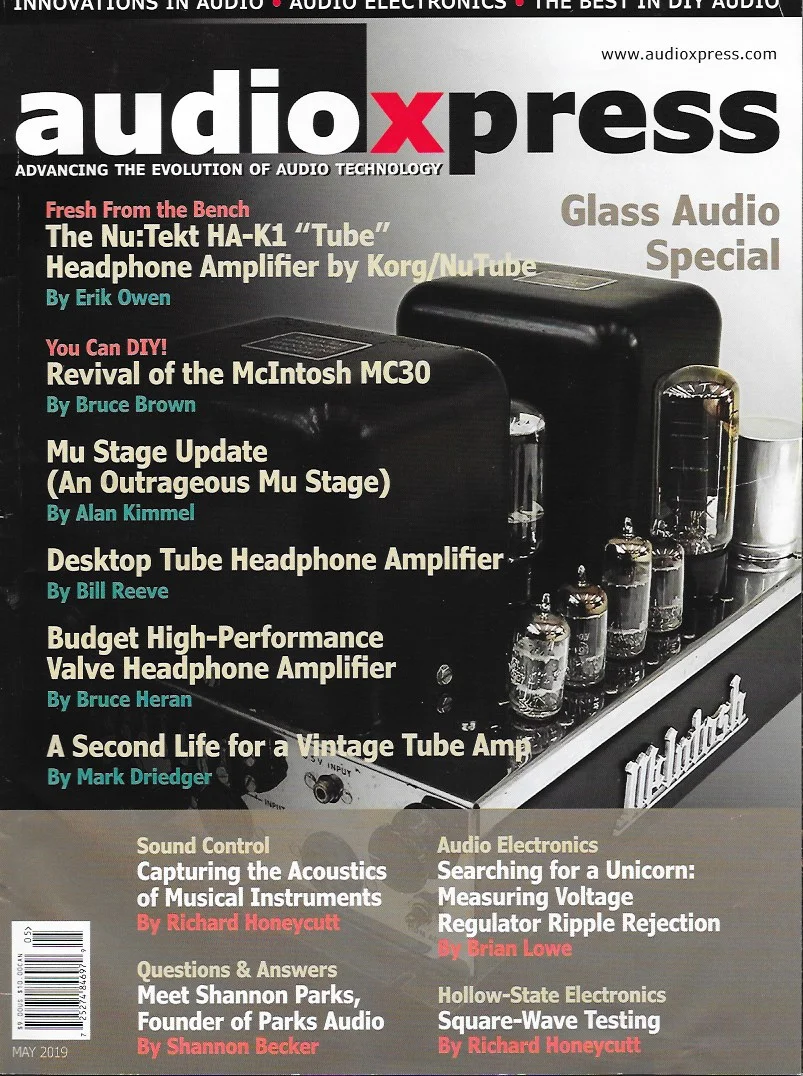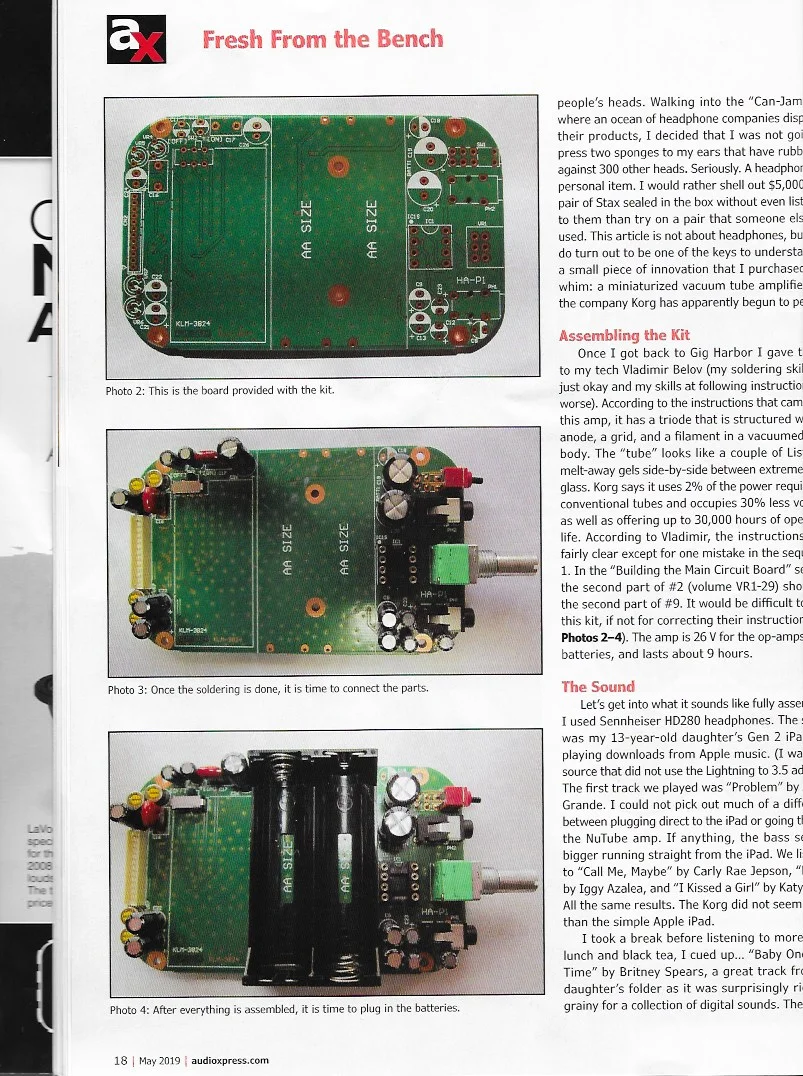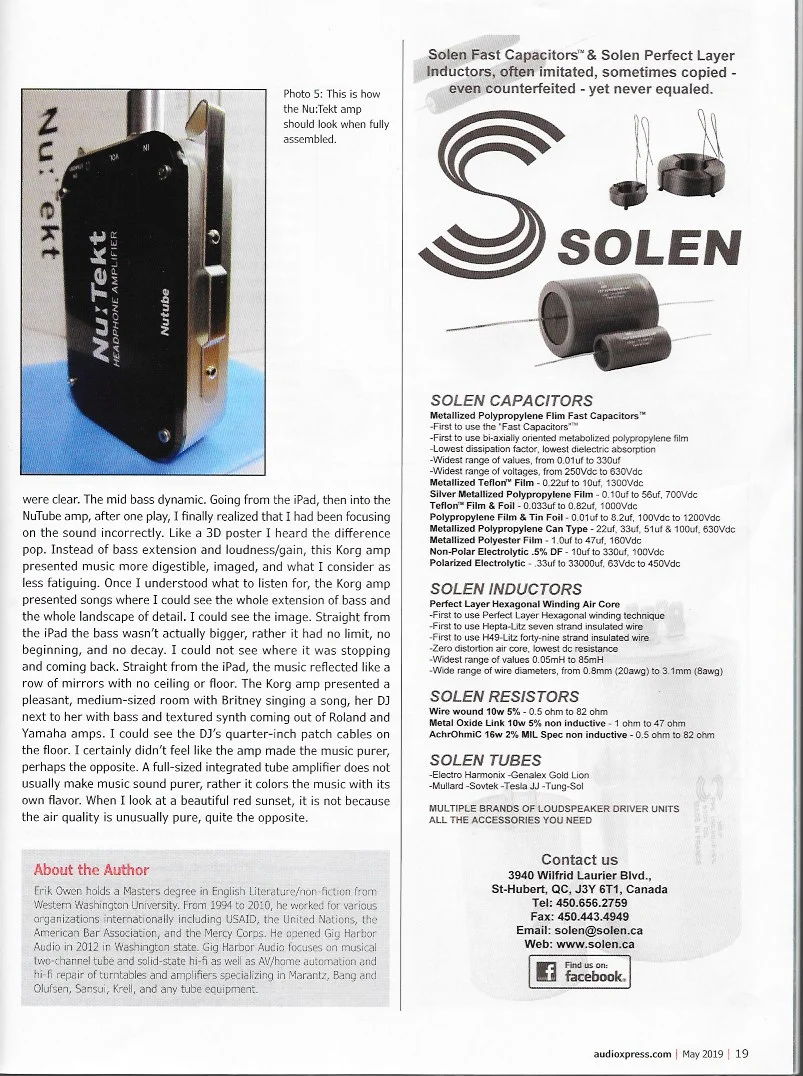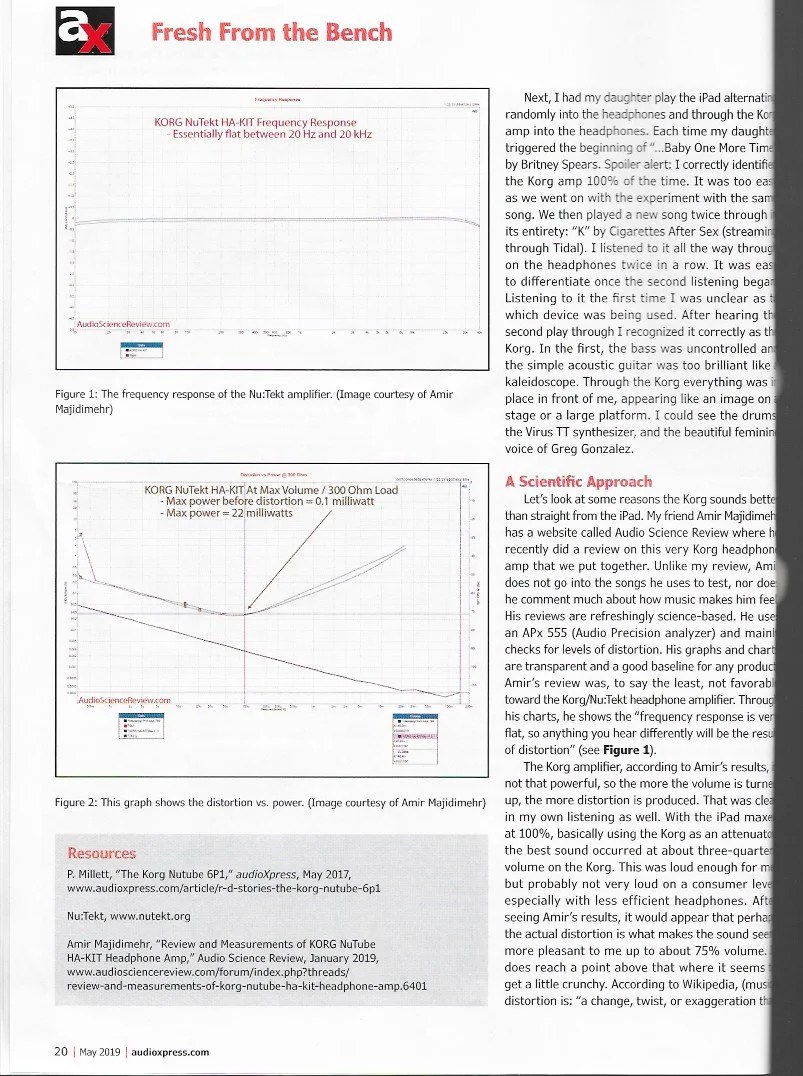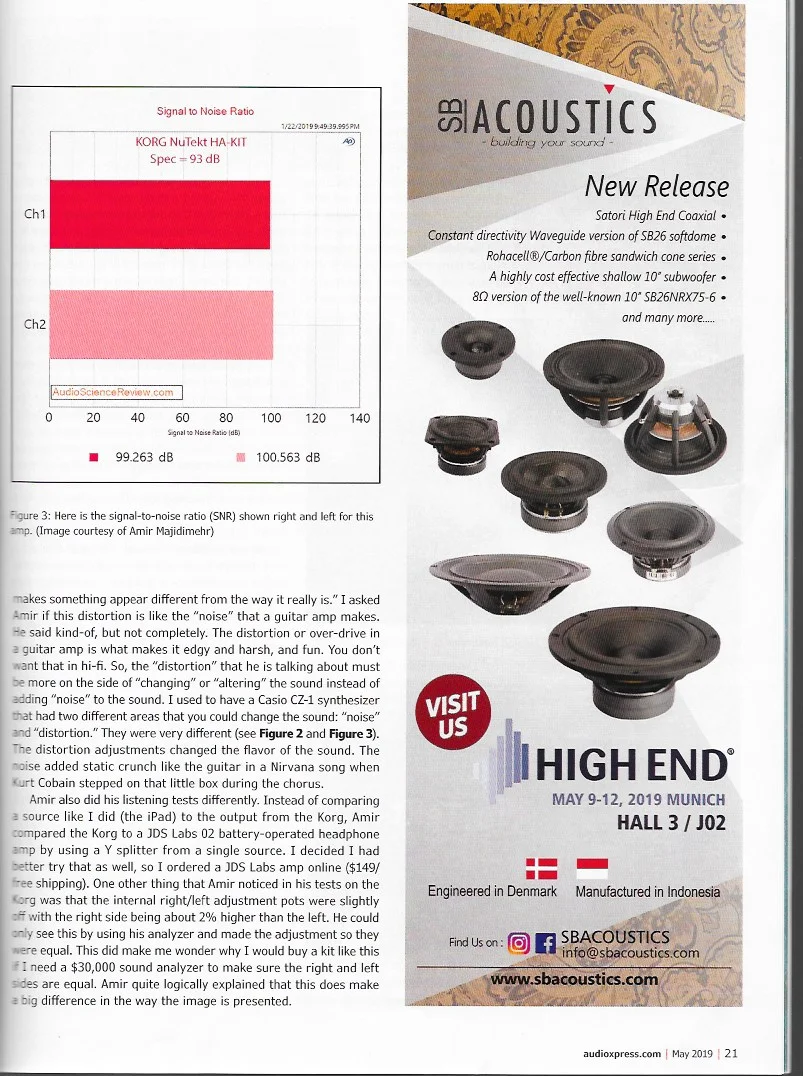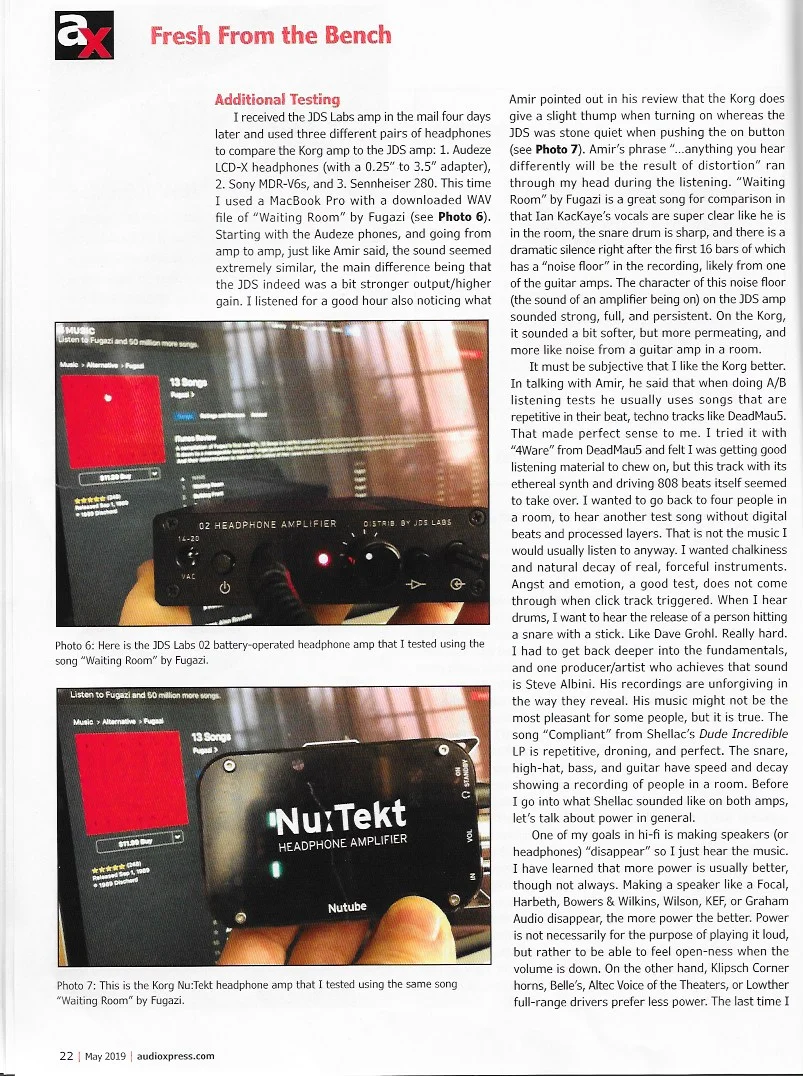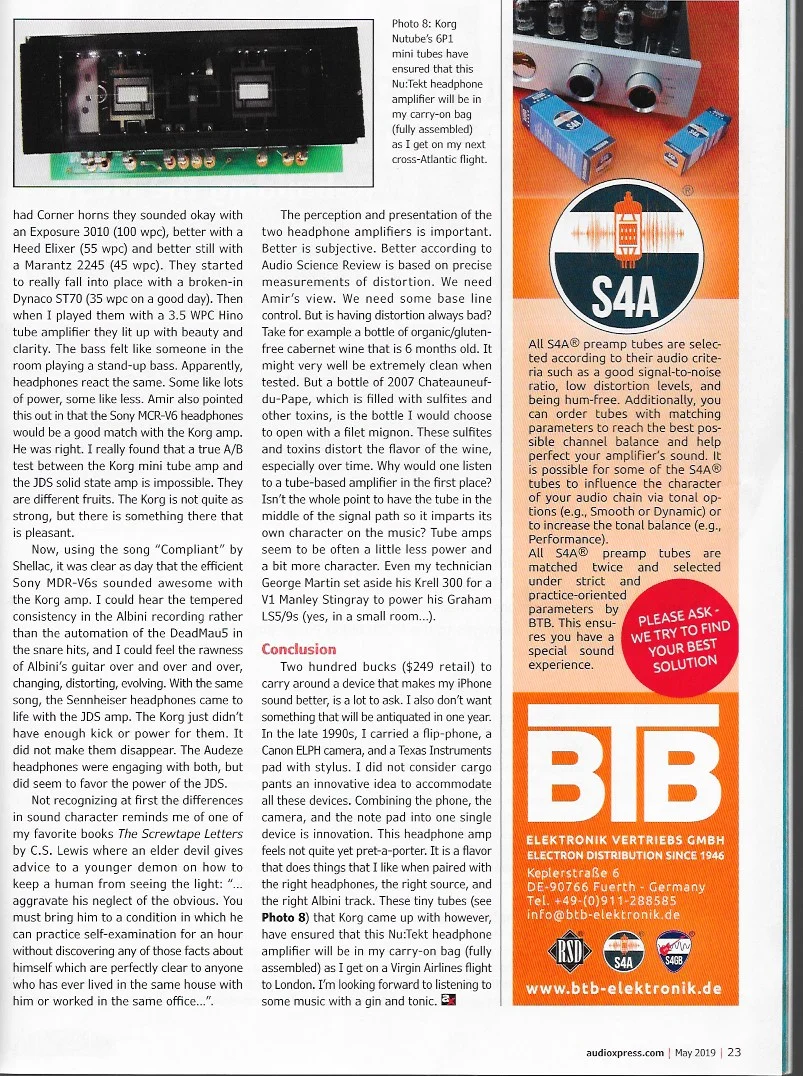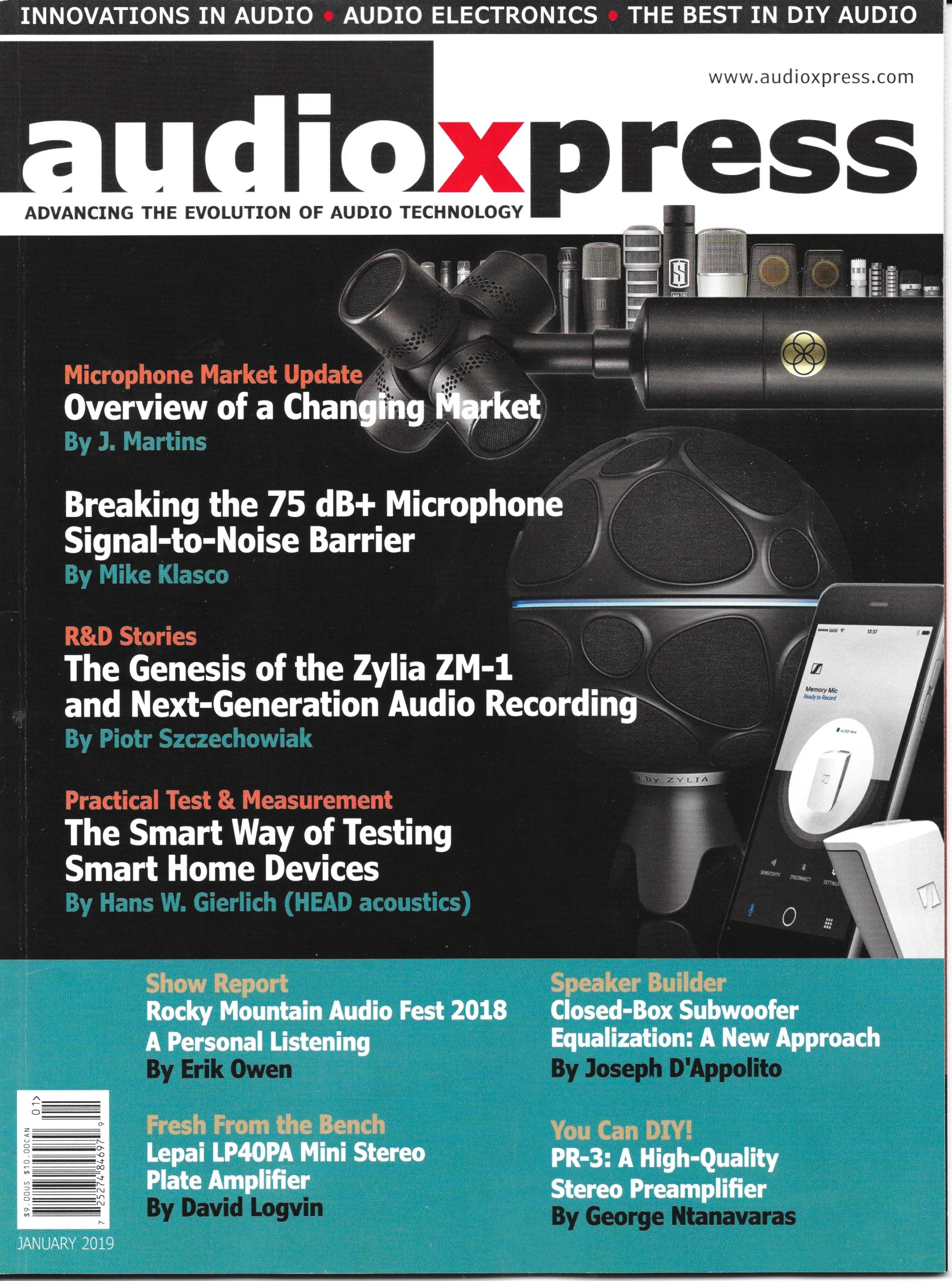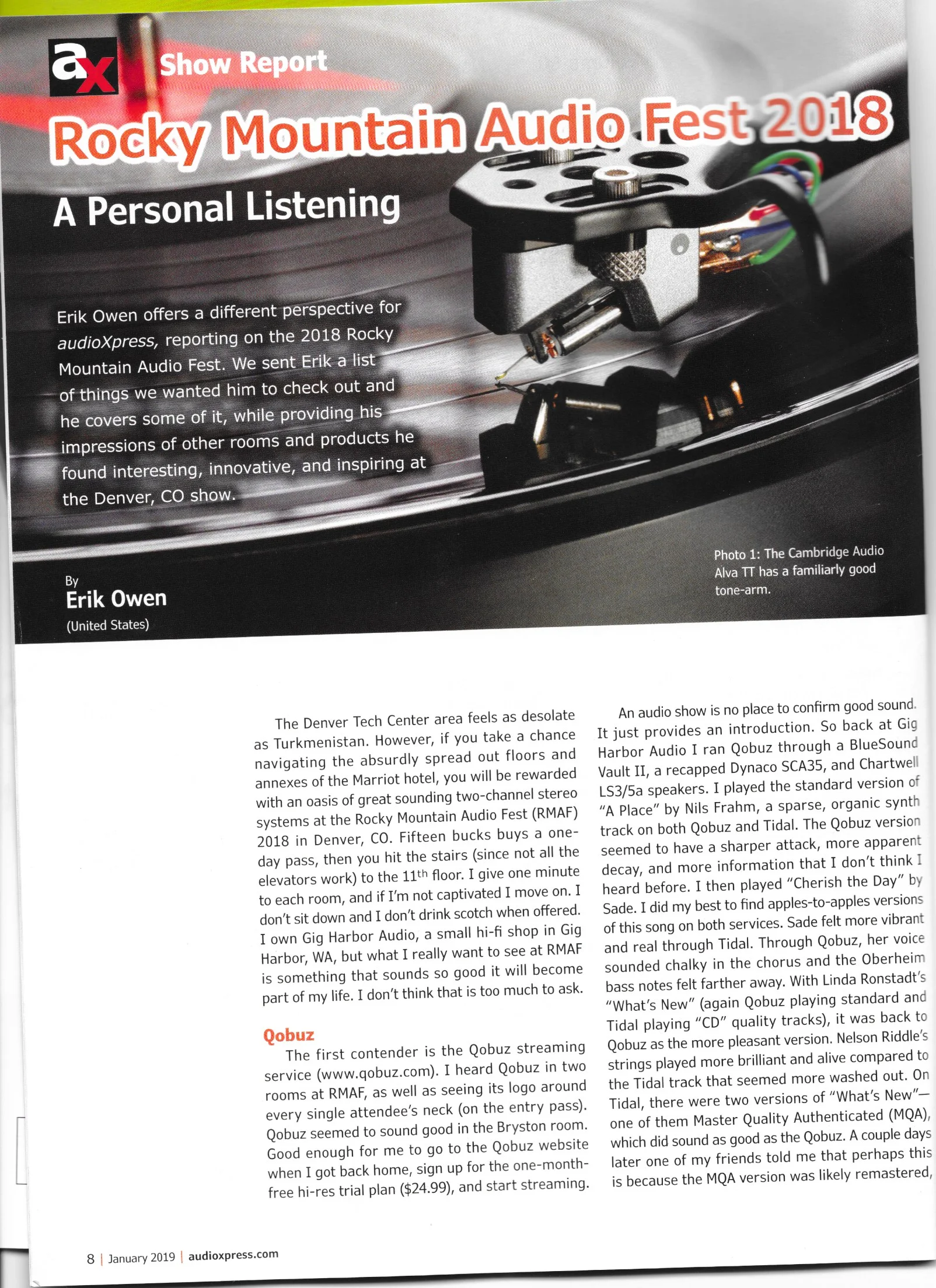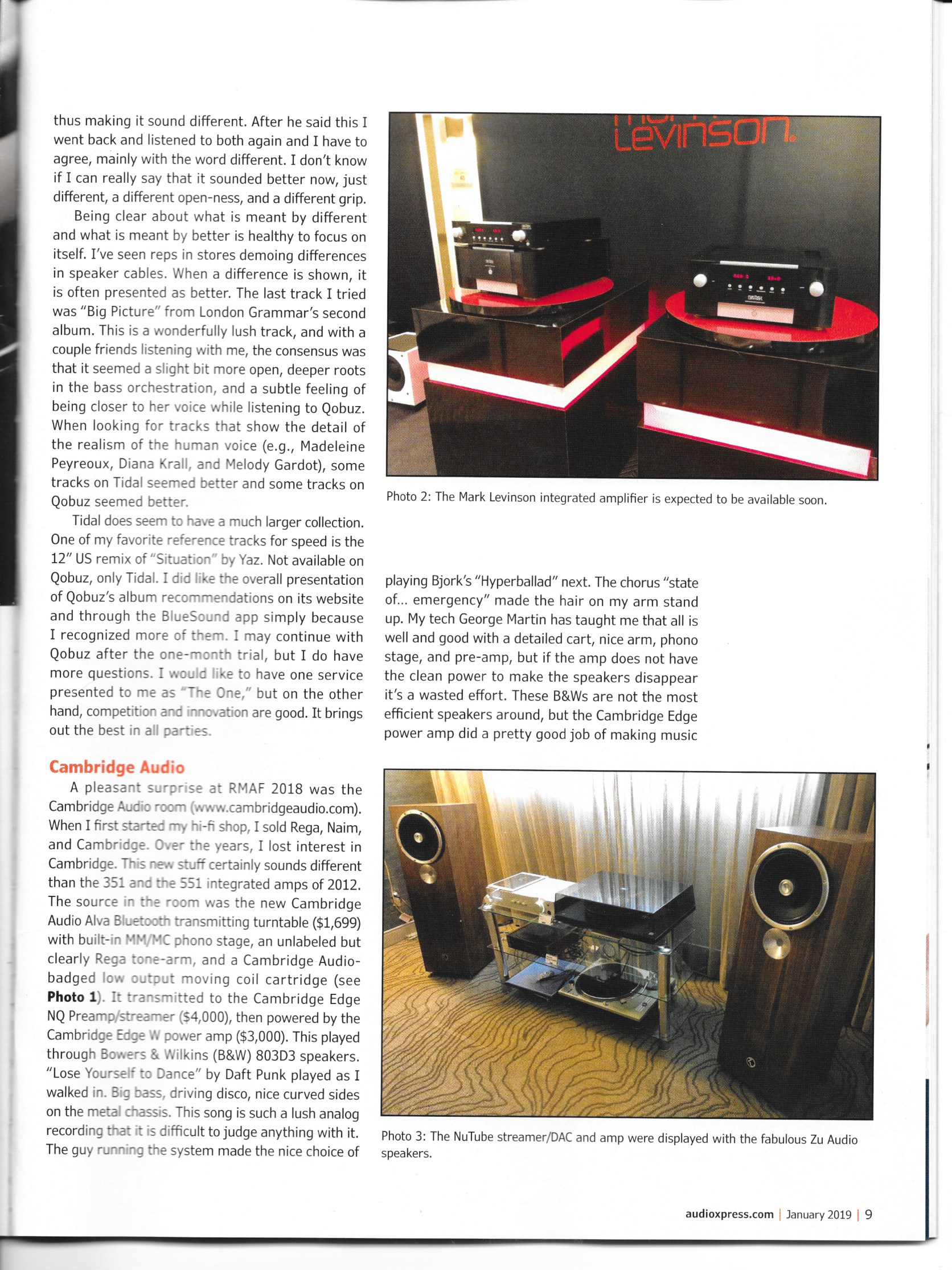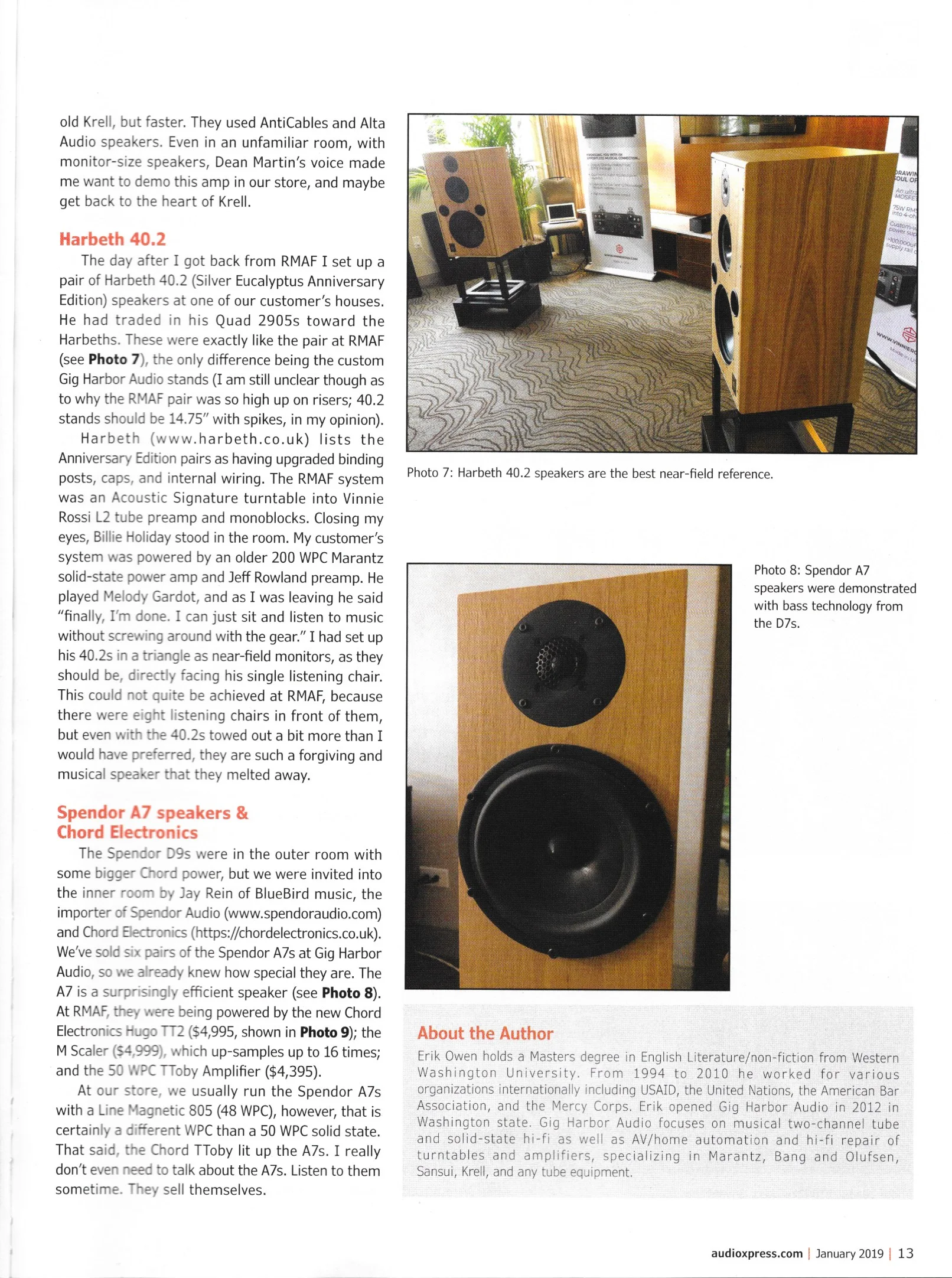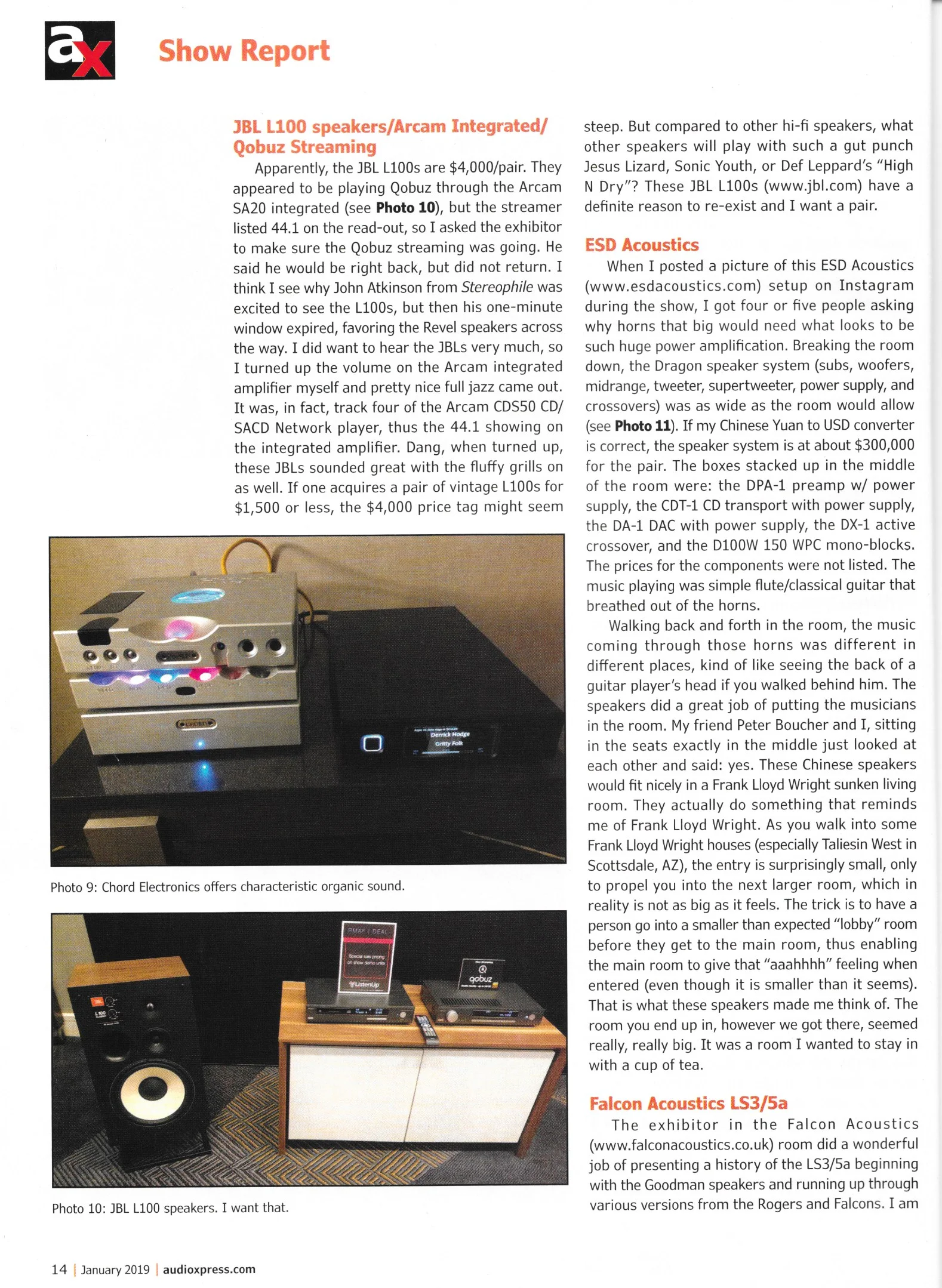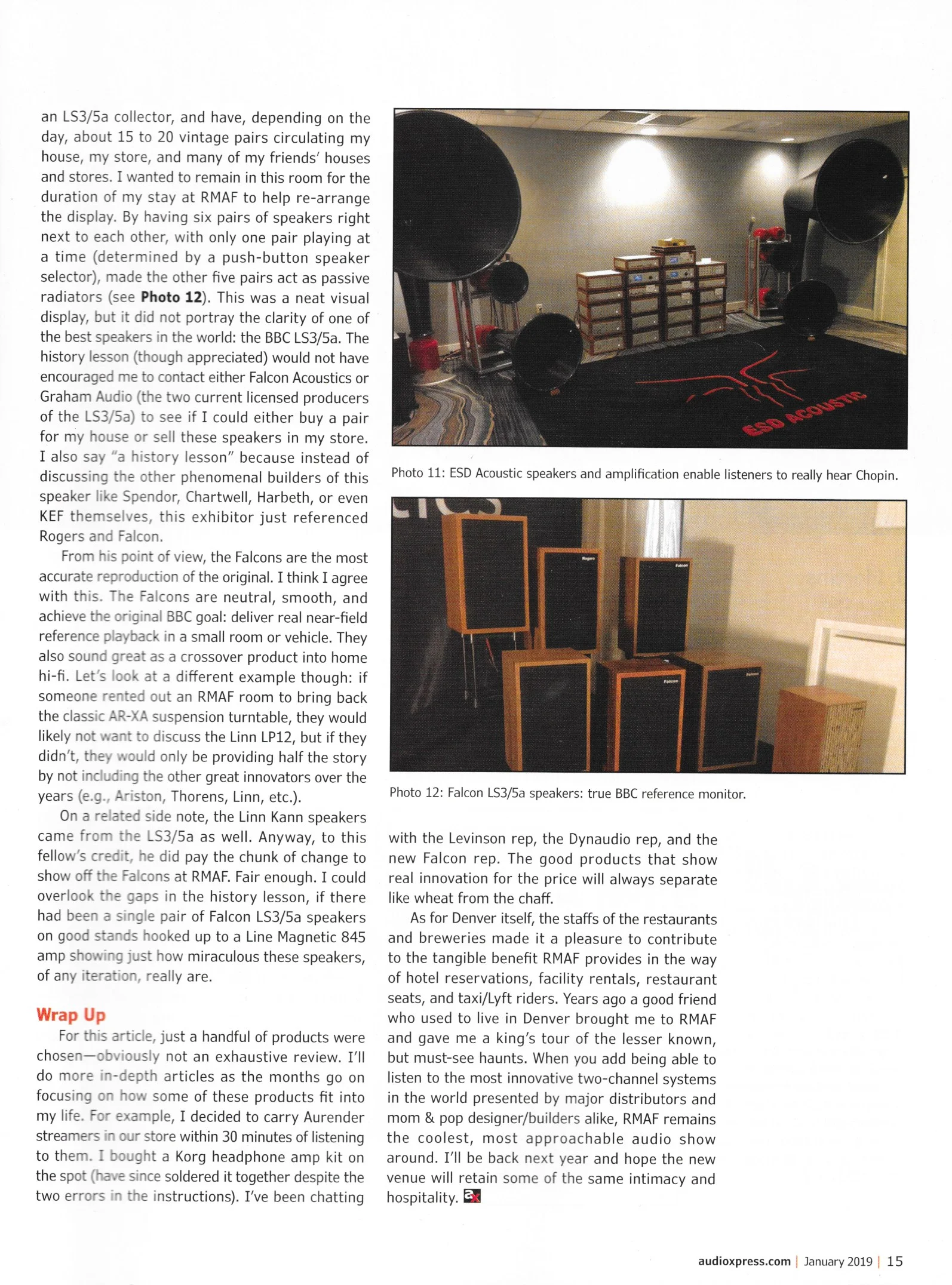Stereophile article by Jason Victor Serinus about a film by Chris Bell focusing on a pair of Altec Flamenco speakers that were rebuilt and enjoyed by Art Dudley and now live at the home of our friend deaf audiophile Bob Lichtenberg.
GHA Launch of Graham Audio LS8/1 speakers →
Art Dudley Review on Chartwell and Falcon LS3/5a
STEREOPHILE MAGAZINE
Graham Audio Launches the LS5/9f
at Gig Harbor Audio
Jason Victor Serinus | Jun 5, 2019
It’s a keeper. Those are the thoughts that stuck with me after listening to the British-made Graham Audio LS5/9f ($7999/pair), a two-way reflex loading loudspeaker that had its US launch at Washington state’s Gig Harbor Audio on Saturday afternoon, May 25.
Most of my listening was to a 15ips tape of select jazz and classical tracks prepared by Yarlung Records—everything from “Missing Miles” from Yuko Mabuchi Plays Miles Davis to Jung-A Lee’s Fantasia from A Private Organ Recital in Walt Disney Hall and mezzo-soprano Sasha Cooke’s Handel. Using an old Pioneer tape deck, Gig Harbor Audio cabling assembled with Dueland wire, and power treatment that included AudioQuest’s PowerQuest 2 and NRG Edison duplex wall outlets, we listened through two very different-sounding integrated amps, the 30Wpc, single-ended Line Magnetic LM845 Premium ($7500 right now, $8000 in a week due to tariffs) and brand new, hardly broken-in 200Wpc Krell K-300i ($7000, $8000 with streaming DAC; review forthcoming). The LS5/9f made it easy to hear how different those amps sound.
The three-hour launch event took place in a relatively intimate space. It was not a quiet space: Owen wants his shop to be friendly. To quote GHA fan Casey Richardson of Federal Way, WA, “How many other hi-fi stores are there where you can sit around and have a beer and talk to people and talk shop all at the same time? I’ve met new friends here; we all go to each other’s houses to listen. This isn’t just a hi-fi shop; it’s a community of people that love hi-fi.”
That’s another way of saying that while lots of people took turns listening on the store’s comfy couch or standing near the sweet spot—a bunch arrived well before the event started—just about everyone spent the bulk of their time sipping beer while chatting informally with new and old friends, including Graham Audio founder Paul Graham, Graham distributor Philip O’Hanlon (On a Higher Note), and store owner Erik Owen.
O’Hanlon was the impetus for the development of the LS5/9f. “[We] were listening to Graham Audio’s little LS5/9 last year, and we were smitten by its midrange magic and how it could sound so good with whatever electronics and cables I had lying around,” he told me. “But we felt that floorstanders would sell better in the US.”
Graham agreed. “A lot of buyer’s spouses didn’t like the look of the stands,” he explained during our 40-minute chat. “This new LS5/9f is based on the classic BBC LS5/9 monitor, but it has about 5Hz more bass extension. We’ve tried to retain the same studio-grade quality and strengths of its monitor predecessor while extending the bass lower. As for its price, when you take the monitor and figure in the cost of good stands, it’s about the same.”
Lovers of the BBC speaker sound probably already know much about the genesis of Graham Audio. “Over 30 years ago, I was buying and selling equipment and started buying stuff from the BBC,” Graham said. “Even if the BBC speakers were in poor condition, we were getting good money for them. So I asked the BBC if I could get a license to reproduce them. Since Rogers had stopped doing everything apart from the 3/5a, they said, ‘Sure.’”
Graham started with the 5/9, but after talking with O’Hanlon, began producing the 5/8, then the 3/5, and then the LS3/5A under license from the BBC. The crossover design remains, but Graham says the speakers are “much better than they used to be because they’re using better components. “Derek Hughes, the son of Spendor founder Spencer Hughes, does all our ‘re-creation’ work for us. Derek has the knowledge from working with his dad, and still has his dad’s notes at home. Everything we do has good lineage, as it were.”
Graham maintains that while the BBC designs were solid, the speakers weren’t particularly well-made. Their early propylene drivers deteriorated “quite badly” with the passage of time, for example, and their capacitors weren’t as good as many modern varieties. In addition, because the performance of supposedly identical tweeters varied widely in the ‘70s, the original 5/9 had a solder pin adjustment on a Traffolyte plate on its front, which enabled owners to solder wire from common to either +.5, +1,+ 1.5 or +2—whatever was necessary to balance the tweeters. The new LS5/9f follows that example with a HF level switch on the front. (We listened with the tweeters set flat.)
The LS5/9f is so new that it has yet to appear on the Graham Audio website, but Derek Hughes sent along specs: Sensitivity is 87dB / 2.83V/ m; nominal impedance is 8 ohms; recommended amplifier power is 50–200 watts; maximum output exceeds 100dB for a pair at 2m; and frequency response is 45Hz-18kHz ±3dB. Drivers are a 34mm soft dome tweeter from Audax and a long-throw 200mm Diaphnatone Polypropylene bass/midrange custom-made for Graham Audio by Volt.
Look for Art Dudley’s comparison of the Graham LS3/5, LS3/5A, and Falcon LS3/5a in our July issue.
Read more at https://www.stereophile.com/content/graham-audio-launches-ls59f-gig-harbor-audio-0#kb2SCTiryK9kkyeg.99
AudioXPress May 2019 Article on Korg/NuTekt headphone amplifier
AudioXPress RMAF 2018
Recapping The HHScott 357 (reprinted from Tone Audio Magazine)
HH Scott 357 Recap (reprinted from Tone Audio Magazine)
There is an old Russian saying that drinking beer without vodka is like throwing your money to the wind. When it comes to restoring vintage hifi, this translates as: make sure your unit is in great cosmetic shape before investing in a bunch of new capacitors. Replacing caps and transistors are as important as enjoying a tall crisp beer after a hard day of work, but if the tuner glass is cracked, your good intentions and cash are about to fly out the window.
Last month our friend Mike rolled into Gig Harbor Audio carrying a bubble wrapped HH Scott 357 solid state receiver. This receiver was a great example of a unit in excellent cosmetic shape, like it had just been removed from Don Draper’s Manhattan office. Mike’s father had played it gently over 25 years until moving it to storage in a dry, clean box for another 2 decades.
The HH Scott 357 is a compact, smart-looking receiver with an FM display that turns from green to warm red when the station locks in! Unlike the rat’s nest of wires hiding in an earlier HH Scott 222 tube integrated, the 357 is a neat and tidy 25 wpc receiver with a punch. Mike was willing to sink in some cash to get it sounding close to what it did when his dad purchased it in 1971. This unit was special because Mike had spent his wonder years enjoying it with his dad, and since it was in great cosmetic shape, he could probably get his money out of it if he had to. Now he can pour a couple icy shots of Grey Goose.
Restored, this mini powerhouse came in at $275 and with all new caps. Our goal with recapping is to get as close as possible to what something sounded like when it first came out within reason. We don’t hot rod units but instead restore them as best we can to deliver: happiness. On this 357 we overhauled the power supply and changed all power supply caps, recapped the tone board and tuner using Nichicon capacitors, re-lamped and cleaned the display, and cleaned all controls and switches with contact cleaner and DeOx-It.
Before giving a unit back to a customer we break it in for at least 4-5 days. There are parts in a restored unit, like Mike’s 357, that were not replaced because we considered them still good. These parts have not experienced a signal passing through them for 25 years and need to get a thorough stress test. Plus the new parts need to break in. Imagine a pair of shoes. They aren’t comfy until they contour to one’s feet over 1-2 weeks. Capacitors, speaker drivers, and even turntable cartridges are the same. They break in over periods of months, even years.
This brings up some of the choices of a tech. Recap every single section in the unit? What if the phono-stage still sounds quite nice and strong? If you recap it you might gain 20 more years of play, but you’ll lose the benefit of break-in courtesy of 25 years ofMantovani and Martin Denny LPs. We shoot for the best bang for the buck to enjoy a unit again.
This success story of Mike’s HH Scott 357 is in contrast to the many people who bring in similar units and ask why they should pay $275 to restore a receiver that they picked up at a thrift-shop for 25 bucks. Great question. If the unit holds no sentimental value of evenings with Mom and Dad, then the receiver might just not be that into you. A good tech will lay out what you’re getting into. A good tech will dissuade you from dropping a chunk of change into a unit that will be hard to re-sell. And the best tech will try his or her utmost to give you the context of a piece no matter what you paid for it and hopefully help you understand and give the proper respect to a piece of audio history no matter what shape it is in. Amplifiers and receivers found on the shelves of thrift stores, relative’s attics, and estate sales are pieces of art, and before the world of 24 hour Twitter feeds, FM tuners were portals from the outside world into a family’s living room.
This Scott 357 receiver now resides safe at Mike’s home. His Acoustic Research EB-101 turntable is plugged into the moving magnet Phono input. Simple tinned speaker wire goes from the receiver to his Klipsch 1.5 speakers which are actually on a bookshelf between Hemingway and Salinger. He uses the warm metal knob to go between Mozart on 98.1 FM and the new Denon DL110 stylus hovering above his turntable platter. A simple, stylish set-up that allows Patsy Cline to come to life. Now he can pour whatever drink he pleases, even if it is just a nice cup of Earl Grey. -Written by GHA
The Art of Making a Mix Tape
We just finished making a mix tape at Gig Harbor Audio. That’s right: an analog tape of our favorite songs. Tape is a great format for arranging a song-list, and we’ll get to all the reasons later. For now though, the Trader Vic's Macadamia Nut liquer is within arm’s reach on a mahogany table at Gig Harbor Audio. Let’s push play. The 10.5 inch black master reels on the Akai GX-625 reel to reel cast spinning shadows onto the shag rug. The first notes of Enoch Light’s Persuasive Percussion bounce from the left speaker to the right on the Harbeth Compact 7-ES3s, powered by a 100 watt per channel Exposure 3010-2SD integrated. The transition from Black Mambo by Glass Animals which was recorded from vinyl to the Tidal music service selection of Siouxsie and the Banshees’ The Passenger is dead quiet. The last song that fits on the second side is the 2013 vinyl release of Steve Albini’s uncompromising recording of Nirvana: “come back as fire and burn all the liars, leave a blanket of ash on the ground…” Forty-two artists become one piece of art that we call a mix tape.
At 7.5 inches per second we recorded from 3 sources: (1) a GHA turntable (The Sunken Living Room), (2) a GHA computer holding about 3 TB of FLAC files, and (3) the Tidal music service. The GHA turntable uses an Acoustic Research t-bar suspension, a Rega 303 arm, a Hurst 300 motor, and a Denon DL103R cartridge all atop a custom bamboo plinth. The phono stage is a Musical Surroundings Phenomena II set to low output moving coil. The second source, the computer, is a mini chassis with an AMD a8 APU processor, and it is controlled through J-River on an Apple IPAD. It goes out via AudioQuest diamond USB cable to a Chord Electronics 2Qute digital to analog converter (DAC). The Tidal service is played through a Sonos Connect streamer which also runs into the 2Qute DAC via AudioQuest Diamond optical cable. About half the tape is recorded from vinyl, and each of these cuts are apparent because we recorded the drop of the Denon stylus as each song begins. The combination of these three sources allows for playing the best cuts from the GHA LP collection, adding the best digital files from our library, and finally giving total creative freedom with the ability to play any song by any artist through the Tidal streaming service. The files on the GHA computer are large FLAC files (up to 192 kHz). Tidal files come through as CD quality (44.1 kHz). All three sources go direct to the Akai reel to reel via Shunyata RCA cables.
As always, we shoot for the best bang for the buck sound. The AR parts used in this turntable cost $20 (by gutting a non-working AR-XA from Ebay), the arm cost a couple hundred, the new Hurst motor cost $59, and the Denon cartridge retails for $379. The bamboo plinth cost roughly $10 in materials (strips cut from bamboo plywood). The time to glue it and set it was about 1 hour. The phono-stage is by far the most expensive part of this source at $750, but that is a pretty good place to put funds. The second source, the GHA computer, is about $600 in parts (not counting our installer’s expertise to put it together). As for the streaming, the Tidal music service costs $19.99 per month for the “lossless hi-fi service.” With that, one can play practically any song through a Sonos Connect ($349). The Sonos actually has a pretty good DAC in it. It’s easy to compare the Sonos Connect DAC to any other DAC by going out RCA from the Sonos at the same time going out optical to a stand-alone DAC of your choice. Compared to many $500 DACs the Sonos was not far behind. It might not be quite as good as the Parasound ZDAC or the Jolida FX (if putting in new ElectroHarmonix 12AX7 tubes), but we were not convinced that spending an extra five hundred to slightly improve the sound was worth it. The DAC that did feel worth it was the 2Qute from Chord Electronics which retails for $1795. This DAC is considerably more expensive, but presents music on the same playing field as a good vinyl set-up: full, great timing, musical, much wider and open soundstage. Granted the AudioQuest optical cable used from the Sonos and the AudioQuest USB cable from the computer are quite pricey at around five hundred bucks each, but we used them because they are worth it. There was an audible difference in the fullness of bass and richness. We are slowly learning that without good cables, it would be like watering a garden with a hose that is too thin for the amount of water needed to grow big sweet tomatoes. The Akai reel to reel itself was purchased for $250 and had another hundred or so put in with cleaning, calibrating and cosmetic upgrades. The ATR tape stock with 2 matching black reels was provided by J-Corder for $120. The result of all this is that the three sources combine seamlessly and all saturate way into the red without distorting on the ATR tape stock.
What was so exciting to us about making this mix tape was not only the choice of songs, but the transitions between the songs and the way each song creates a context for the next. Artists like Man Ray, Mapplethorpe, and Picasso extracted resounding meaning from objects by simply placing them next to other objects. When a mix tape is played at a party, with the revolutions of the metal reels, each individual song is listened to. Like in an anthology of literature, a poem by Richard Wright is understood as it should be: as important as one by John Keats. Union by The Neurotic Outsiders is the 5th song on side 2. Steve Jones, the former guitar player for the Sex Pistols steps right into your living room. This catchy, tragic song hashes out Jones’ difficult relationships with Sid Vicious and Johnny Rotten. When this composition is placed between the bookends of Walking the Cow by Firehose and Train’s cover of Led Zeppelin’s Heartbreaker the 3 Sex Pistols’ personalities receive a deserved second look like placing a rotten apple next to a diamond in a Damien Hurst art show.
An analog mix tape feels more like a roll of Kodak film with 24 exposures than a digital camera. Each exposure feels important because film is expensive and it needs to be developed. Each shot is framed and set up to ensure that it carries its’ own weight. This is a far different process than using a digital camera and shooting as many shots as you want and downloading them immediately. Perhaps it is Biblical. We reap what we sow. Making a digital playlist on an IPAD takes 5 minutes. The time, energy, and memories that go into making a 44 song mix tape on a reel to reel last a lifetime. Each song is checked individually for meter level. Each song is recorded in real time which means that all the activities like enjoying a glass of wine or playing backgammon with friends while making the recording are triggered upon playback. By carefully cleaning the record heads with rubbing alcohol, choosing good RCA cables, and squeezing the most out of each song through the cartridge, phono-stage, and DAC, we felt like we took ownership of each of our favorite songs.
The Zoo by The Scorpions, the 19th song on the first side, is a Japanese pressing. As we understand, this means a couple different things: in the 60’s Toshiba apparently used various techniques on their vinyl production that proved superior. Also, they had lower production runs with the master stamp, thus the chance of getting a hot-stamper LP was much higher than the larger production runs usually done in the U.S. This Scorpions LP is definitely a hot-stamper. We have 5 copies of Animal Magnetism by The Scorpions at GHA, and none are particularly engaging except for this Japanese pressing. It is stellar. The driving guitars are mesmerizing and rich. Klaus Meine is on fire. The next song on the tape, following these German rockers, is a track either despised or loved: Fancy by Iggy Azalea. Seriously. Recorded from a hi-resolution FLAC file, it is as phat as a hard-lead synth-bass played directly to the board from a Roland Juno-106 synthesizer. This song is defined as expropriated attitude, jacked lyrics, and questionable swagger or it is sung along with and enjoyed because it is very simply: a good hit. The Zoo and Fancy could not be more different: vinyl and digital, guitar rock and synth pop, prophetic lofty lyrics and jaded fronting rap. It is however the transition between the two songs on a spinning analog reel that tells the actual story, dead black noise-floor and saturating bass. They are now two well recorded compositions included in the ongoing GHA Canon. –GHA
Side 1
Pack of Cigarettes –Vopli Vidaplyasova (Ukrainian, 1994)
Sunrise – Larry Carlton (2006)
Its My Life (Extended Analog Mix) – Talk Talk (1982)
Only Tongue Can Tell – The Trash Can Sinatras (1989)
Spirit in the Sky – Doctor and the Medics (Norman Greenbaum cover, 1986)
Iskala – Zemfira (Russian, 2000)
You Ain’t Me – Black Francis (Frank Black, 1996)
In a Big Country- Big Country (1983)
Betty Davis Eyes – The Moon Loungers (Kim Carnes cover, 2016)
Luminol – Ryan Adams (2003)
A River has Two Sides –Shura (Шура, 2000)
Paradise – New Order (1986)
Horse Doctor Man – Jesus Lizard (1998)
New York – Cat Power (2008)
The Table – The Beautiful South (1998)
Swamp Thing – The Chameleons UK (1986)
Black Mambo – Glass Animals (2014)
The Passenger (extended version) – Siouxsie and the Banshees (1987)
The Zoo – The Scorpions (1980)
Fancy – Iggy Azalea (2014)
Believing is Art – Spoon (2001)
Naïve Melody –Talking Heads(1983)
Side 2
Bond Street – Enoch Light (1969)
Eddy’s Ragga – Spoon (2007)
Flip Switch – Enoch Light (1970)
Walking the Cow – Firehose (1983)
Union – Neurotic Outsiders (1996)
Heartbreaker (Led Zeppelin cover) – Train (2016)
Proud to Fall – Ian McCullough (1989)
Trance – Enoch Light (1972)
Fine Time – New Order (1989)
John the Revelator– Depeche Mode (2005)
Gimme Shelter – The Frank (2010)
Ask – The Smiths (1988)
Little Red Corvette (extended version) – Prince (1982)
Sidewinder - Lee Morgan (1964)
Marigold - The Ocean Blue (1991)
I Want Candy - Bow Wow Wow (1981)
One Thing Leads to Another - The Fixx (1983)
Slinky Thing - Donald Fagen (2012)
Forget It - Blood Orange (2011)
Cantaloupe Island - Pancho Sanchez (2009)
Making Plans for Nigel - XTC (1979)
Echos - Pink Floyd (1971)
Goodbye to You - Scandal (1982)
Frances Farmer Revenge on Seattle – Nirvana (1993)
Speakers Break Us In
In the early 1960s, on his IBM Selectric typewriter, Hunter S. Thompson copied down the entire novel A Farewell to Arms. He wanted to feel with his own hands the flow and rhythm of his favorite writer: Ernest Hemingway. The words in this amazing book, the sentence structure, sometimes long and detailed, sometimes blunt and precise, shaped Thompson’s own revolutionary style of writing.
In front of you is a pair of speakers. Each speaker is twenty-one inches high, twelve inches wide, and fourteen inches deep… a bit larger than usual bookshelf speakers: roomy. These speakers have Audio Nirvana drivers that are 6.5 inches in diameter mounted four inches below the top. There is a single hole 3.5 inches in diameter that is four inches from the bottom of each speaker. Simple: one driver, one bass port. The cabinets of the speakers (the boxes) are bamboo plywood constructed with wood glue; no nails, no screws. They are completely hollow save for a two inch thick layer of natural lamb wool that covers every inside surface.
These speakers have never been played. Rap your knuckles on the outside of one. The wood is hard, but releases a pleasant hollow knock of reverb. Rap your knuckles again. It gives a nice knock that resonates in the room. You’re in a cozy living room with shag rug, a brown sectional, a cloth easy-chair, and round walnut tables with shaded lamps. There is a real fireplace across the room from where the stereo is set up, the fire ripping around a log of madrona that will burn forever. You drop the needle on the Acoustic Research turntable running through the Marantz receiver. Into the virgin speakers the moving coil cartridge translates: The Immigrant Song by Led Zeppelin, nice and loud.
The speaker drivers are starting their first shock of break-in, like running through woods before a path is worn. The soft surrounds and the spider of the speaker drivers stretch. Micro-cracks in the diaphragm epoxy spread and allow the cloth fibers to move more freely, to bend and to twist. The spider is becoming supple. The speakers are experiencing something they thought impossible, yet it seems like Jimmy Page was inside them the whole time.
When Robert Plant is finished, rap your knuckles on one of the speakers again. At first your knuckles might not sound different on the grained wood, but if you play music through these speakers day after day, a mystical change will grow in the fibers of the wood, the vibrations will find themselves, the dark reverb will deepen, and the natural wool insulation will remain beautifully invisible. Hunter S. Thompson didn’t copy a couple pages; he copied down an entire book.
The tree that this bamboo came from still carries attributes of many generations of plants, animals, and people who lived and died in the soil around it. This wood was brought from distant countries like East India and China. Families and entire lineages make up the character of this wood. Oral history courses through them. Their music is revitalized with every generation. They create, innovate and better the land, like immigrants. -GHA
YOGA = A GREAT STEREO
The definition of Yoga is: actively thinking about doing an activity, then doing it. Really, that’s it. That is Yoga at its core. For example, a guy, let’s say named Gordon, can practice Yoga by visualizing the cutting of a tomato, then walking over to the kitchen and actually cutting it. That is Yoga. All the rest about the breathing and the postures came into Yoga later. Our friend Gordon sits in his living room on his sectional couch, eyes closed, visualizing himself walking into the kitchen, picking up a bright red tomato, washing it under cold water and placing it in the middle of a wood cutting board. He purposefully picks up a sharp knife, then slides it through the flesh of the tomato. This all happens in his mind. Finished with the activity in his mind, Gordon actually gets up from his couch, walks over to the kitchen and cuts the tomato in half. Yoga “connects” or “unifies” the life of the mind and the life of the body. To do this properly, one must make sure the two parts are actually divided. Yoga then places a “yoke” between them like a horse pulling a carriage. And it makes the actual eating of Gordon’s tomato better than ever.
Yoga is also visualizing then actually listening to music on a really good stereo system. Seated in his leather Eames Chair, after enjoying that sweet red tomato, our friend Gordon now visualizes himself walking over to the low wood table and pushing with his right index finger the power button on his modified Jolida JD-9 phono pre amp (the one that 2 months before he had himself soldered in upgraded AriCaps and with white cloth gloves carefully inserted GE 12AX7 tubes). He then pushes the on switch into the upward position on his PrimaLuna Dialogue HP integrated amplifier bringing the eight Electro-Harmonix EL34 power tubes slowly into full glow. He visualizes engaging the silent Hurst 300 motor of his Acoustic Research XA turntable, its custom wood plinth radiant in the light. The Rega RB-303 tone-arm tracks fluidly in its own space, the Denon DL110 high output moving coil cartridge is lowered on the black vinyl, ready to enter the first cut of the pivotal BDB LP Check Your Head. Gordon’s turntable digs into Robin Zander’s voice prophetically introducing the Beastie Boys which now flow through AudioQuest speaker cables, radiating from his Harbeth 30.1 reference monitors which are mounted on solid four post 18 inch stands spiked into his shag carpet. This all happens in Gordon’s mind. Now, in real life, he gets up from his Eames Chair, slowly turns on the vacuum tube amplifiers, spins the platter on the turntable, and without dropping the needle just yet, sits back down to let the amplifiers warm up properly. He meditates on the floor, cleaning his mind. He sees a mountain top, then a slow moving river, then a piece of white paper, then a cloud, then nothing at all. After 1 hour of meditation, he reaches over and drops the needle, starting into motion the main principle that comes from the ancient Hindu text the Bagavad Gita which is literally translated as “The Song of God.” -GHA
Enjoy Music on Your Terms
Are you intimidated by listening to classical music because you feel that you don’t know enough about it? Now you can listen happily to any type of music with the aid of Literary Criticism. The first helpful technique is called New Criticism. It argues: the only thing important about a piece of art is the piece itself. Example: if you’re listening to Bach’s Christmas Oratorio, the only thing that is important is the music coming out of your stereo speakers. Nothing else. Bach’s intentions of how you should feel when listening to the piece are not important. The politics of 1730’s Germany have nothing to do with what you’re listening to. The career of the conductor Nikolaus Harnoncourt is irrelevant. The pieces of music on which Bach drew to create the Christmas Oratorio are also irrelevant. New Criticism rejects all meaning superimposed by history or context. New Criticism focuses on a single work of art… period. A New Critic sits in his/her chair, lowers the tone arm onto a vinyl, and listens. They focus on the form, the content, and the flow of a composition. Now, any piece of music is yours... all yours in the moment you listen to it.
Once you feel comfortable with New Criticism, you can move on to Reader Response theory. This is super fun. It focuses solely on the reader, or in this case: the listener. Reader Response holds important the listener’s reactions to the work. It recognizes the reader/listener as the most important part of the piece of art. The song cannot exist or be beautiful without the listener. The listener completes the arts meaning through his/her interpretation. Everyone remembers where they were when they first heard Sgt. Pepper. Anyone could certainly explain how they felt when they listened to Boston’s More Than A Feeling for the first time, the pinball machines chinking in the background. And their experience builds and becomes it’s own performance art when they hear it for the 50th time. Can a person remember the first time they heard it? They can remember the memory of it, that is for sure. The mind draws on all the experiences and relations of the earlier times of hearing More Than A Feeling as one shot pool in a dim bar in New York or Seattle, the smell of hand rolled tobacco coming from the next room. The psychology of the listener is the focus. The music is important because the listener is important.
Armed with these two opposing, but complementary theories, we’re now able to come up to any album, put it on our turntable, and fully make it our own. Once you feel that you have taken possession of your album, then you can enjoy the bonus of revisiting all the issues that these critics were reacting against. For example, from start to finish, let’s imagine you listen to Bob Dylan’s Desire. The first time (you as the New Critic) are simply blown away by the entire album, especially the first song: Hurricane.´ You enjoy the drum fills, you love the driving guitar, you love the most powerful voice in popular music. Then as time goes on and you listen to it more and more, you (now as the Reader Response critic) realize that your memories of this song are almost as powerful as the song itself. Culture seeps in. You are intertwined with the smooth Matthew McConaughey as he strolls into a bar in the movie Dazed & Confused. You realize that this song is built of your understanding of the song, your relations and memories. When you put this song on, it brings you back to a certain place.
Now, finally, after all this, if you feel like it, you can go back to what the Russian and American university professors were reacting so strongly against during their analysis of art: historical context. It is not that they had any sinister plot to erase history, but it just got in the way of allowing a student a clean first analysis. You can now take your time, and figure this out on your own terms. You can find out what is behind the song Hurricane by Bob Dylan. You can learn how Rubin Carter, a professional middleweight boxer, was wrongly accused for a triple homicide. You hear the story of Rubin, Dylan’s critique of society, and rock. Now, go ahead, put on Bach’s Christmas Oratorio. Enjoy the 14th section with the clarinet. Pour yourself a Scotch or a nice cup of tea as the needle drops. You can figure out the history and context later. -GHA


